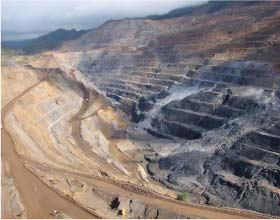Iron is the most commonly used of all metals and accounts for the majority (est. 95%) of the world’s total annual metal production. China continues to be the main importer of the mineral and driver of global demand. China’s daily crude steel output rose to a record 1.945 million tonnes in mid-March, as steel mills banked on a pickup in demand when construction activity generally picks-up in April. In July last year India banned iron ore exports from Karnataka state, which supplies 1/4 of India’s iron ore, in a move to preserve supplies for domestic steelmakers. Recently, however, the move was recently overturned by India’s top court. Brazil, Australia and India are the world’s three biggest iron ore exporting nations.

Mining and steel analyst Rafael Weber, from brokerage firm Geraçao Futuro in Brazil, believes iron ore prices could increase by approximately 22% in the first half of 2011. He noted that Brazilian miner Vale, the world’s largest iron ore producer and exporter, has already set a price hike of 7-8% for the first quarter. The world’s top three iron ore miners: Vale, BHP Billiton and Rio Tinto, switched to a quarterly iron pricing system in 2010 replacing the benchmark arrangement in which iron prices were negotiated each year. Higher spot iron ore prices this February, which recently approached the record levels set in 2008 (just over $200 per tonne), have prompted some miners including BHP Billiton to advocate a monthly pricing scheme. With increasing market transparency and increasing prices, 2011 is certainly shaping up to be another interesting year for iron producers.
6. Labrador Iron Mines Holdings Limited (TSX:LIM)
Along with having the longest name on our list, Labrador Iron Mines is set to become Canada’s next iron miner. The company has a collection of iron ore properties in western Labrador and North-Eastern Quebec within close geographical proximity. The properties collectively contain approximately 150 million tonnes of iron ore resources (historical estimate of which 40 million tonnes has now received NI 43-101 compliant status) grading between 56% and 58% iron. The ore will be processed for shipping (crushing-screening-washing) at the companies centralized Silver Yard plant which is currently in development.
On April 26th, 2011 the company completed a $110 million offering ($12.50 per common share and $15 per flow-through share). The intended use of the financing is to upgrade and expand the Silver Yard plant, payments under the company’s rail transportation agreements, exploration and development and general working capital. When talking with MiningFeeds.com, analyst Geordie Mark notes, “Labrador Iron Mines is set to become Canada’s next iron ore producer coming into production this month. The company intends to deploy the cash from its recent financing and cash-flow from operations to expand output over the next few years so the timing looks perfect to take advantage of elevated iron ore prices.” The Haywood analyst has a 12 month price target of $17.70 per share. His firm, Haywood Securities (or an Affiliate), managed or co-managed or participated as selling group in a public offering of securities for Labrador Iron Mines in the past 12 months. Shares of Labrador Iron Mines have been recently trading between $12.50 and $13.50 per share.
Consolidated Thompson Iron Mines (TSX: CLM) was the last Canadian iron ore company to reach production. On January 11th, 2011 the company announced that it was to be acquired by Cliffs Natural Resources for $17.25 per share in cash representing a transaction value of approximately $4.9 billion.
7. Copper Mountain Mining Corp. (TSX:CUM)
What does an experimental electronic music band from the UK called The Shamen have to do with Copper Mountain? Admittedly, that is a very difficult question. The Shamen’s first (and only) top 40 hit in the U.S. was released during the summer of 1991 and could very well be the perfect theme song for Copper Mountain. That song was “Move Any Mountain” and that’s what Copper Mountain is about to do – all the way to Japan.
The company owns 75% of the Copper Mountain mine, and their Japanese partner, Mitsubishi Materials Corporation, owns the other 25%. The 18,000 acre mine site is located 20 km south of the town of Princeton in southern British Columbia. The mine has a resource of approximately 5 billion pounds of copper and the project is fully financed and nearing completion. Pre production mining activities are underway and the mine is set to enter production next month to produce approximately 100 million pounds of copper each year. Shares of Copper Mountain have performed well over the past 12 months moving from $2.70 last May to $6.78 per share today.
The mine will utilize conventional crushing, grinding and flotation processes and equipment. Once the copper concentrate is produced, it will be shipped to one of Mitsubishi Materials’ existing copper smelters in Japan. First, by rail to the port of Vancouver, and then by ship across the Pacific Ocean. B.C. Minister of Transportation and infrastructure Shirley Bond recently stated, “This really shows how the Pacific Gateway is the best transportation route for Asian businesses.” And, “Mitsubishi Materials Corporation invests in the B.C. Copper Mountain Mine to get the copper concentrate they need, knowing that the best way to ship it is through the Port of Vancouver.”
MiningFeeds.com connected with Jim O’Rourke, Copper Mountain’s President & CEO and 2005 recipient of the Edgar A. Scholz Medal for Excellence In Mine Development in British Columbia and the Yukon to find out more about the company as it nears production. For the exclusive interview – CLICK HERE.
For 10 Base Metal Stocks to Watch in 2011 – Part 4 – CLICK HERE.



 Follow us on Twitter
Follow us on Twitter Become our facebook fan
Become our facebook fan










Comments are closed.